
These reptiles don’t use venom to catch their prey.
Instead, they wrap their muscular bodies around their victims and squeeze until the animal can’t breathe.
Some constrictor snakes can exert crushing pressure that is strong enough to take down animals much larger than themselves.
You’ll find these hunters living in forests, swamps, and grasslands around the world.
From the massive green anaconda in South America to the mighty reticulated python in Asia, each species has its own special way of using strength to survive.
7 Most Powerful Constrictor Snakes
Let’s start our list off with a bang. Or should I saw a squeeze. Meet the most powerful constrictor on earth.
1. Green Anaconda
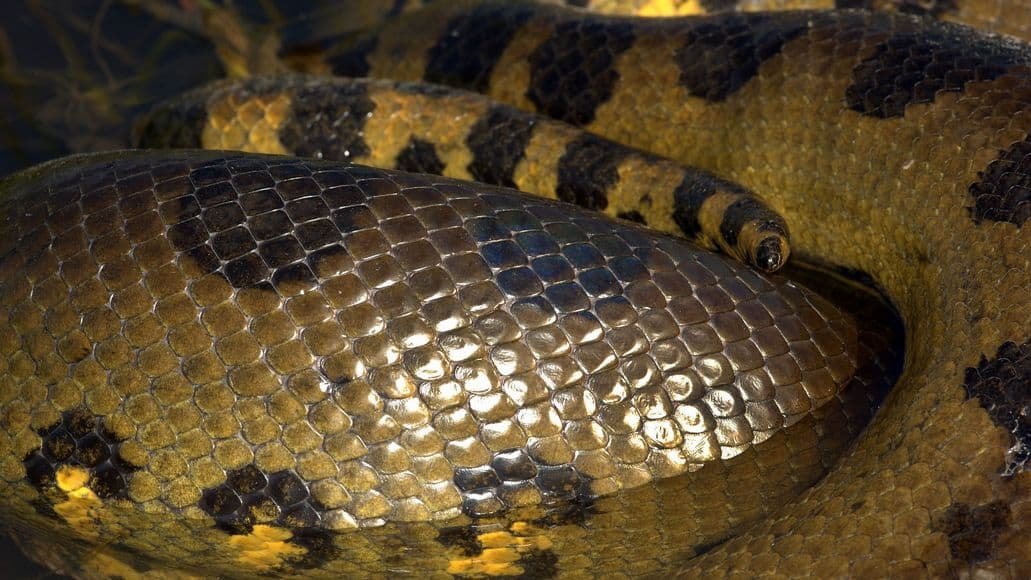
The green anaconda is the strongest constrictor snake in the world. You’ll find this massive serpent in South America’s Amazon basin and wetlands.
This snake also holds the record as the heaviest snake on Earth. It can reach lengths of up to 30 feet and weigh over 500 pounds.
An 11-foot green anaconda can squeeze its prey at 93 PSI. Larger anacondas have even more crushing power.
These snakes live near water sources like swamps and slow-moving streams. They’re excellent swimmers and prefer staying close to rivers and marshes.
Green anacondas hunt large prey including deer, capybaras, and caimans. They use their strength to coil around victims and squeeze until the animal can’t breathe.
You won’t find venom in these snakes. They rely completely on their muscles to catch and kill prey. The anaconda’s thick, muscular body gives it incredible constricting abilities. When it wraps around prey, escape is basically impossible.
These giants prefer aquatic environments where they can hunt fish, birds, and turtles. Their size and strength make them the top predator in their habitat. It also mad e them the star of one of the best snake movies ever made (not a good movie, mind you, but definitely an entertaining one)
2. Reticulated Python
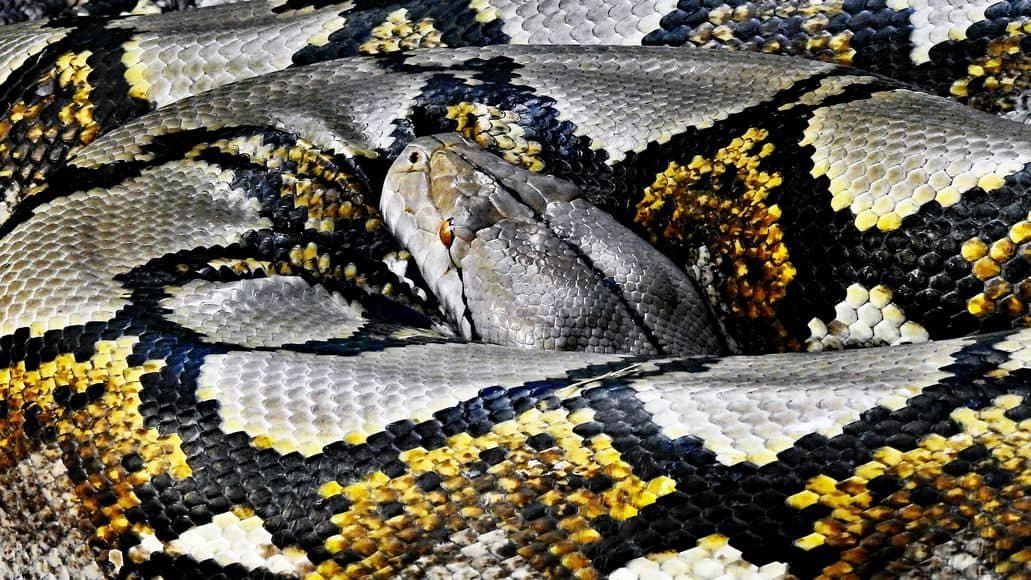
You’ll find the reticulated python in South and Southeast Asia. This snake holds the record as the world’s longest snake species. These pythons can grow over 20 feet long. Some have reached lengths of 25 feet or more. The largest recorded individual measured an incredible 32.8 feet.
You can recognize reticulated pythons by their complex geometric patterns. Their scales show browns, greens, and golds in diamond designs. These patterns help them blend into their surroundings.
The reticulated python is a non-venomous constrictor. It kills prey by wrapping around it and squeezing tightly. This cuts off blood flow and breathing.
They climb trees and swim with ease, letting them hunt both on land and in water. They’re excellent swimmers and can travel far out to sea, spreading to many small islands.
These pythons live in rainforests and grasslands, sometimes staying near water sources. Their strength and size make them one of nature’s most powerful predators.
3. Boa Constrictor
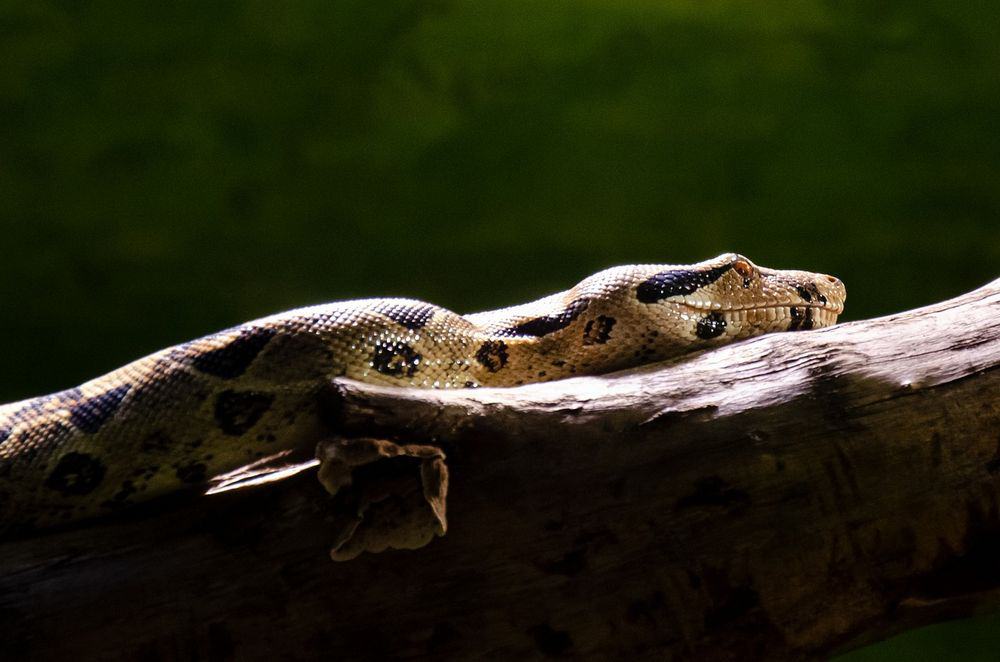
The boa constrictor is one of the most well-known snakes in the world. You can find these reptiles in Central and South America.
Most boa constrictors grow between 6 to 10 feet long. Some can reach up to 13 feet in rare cases. You’ll notice their thick, heavy bodies covered in smooth scales. Their colors range from browns to greens with unique patterns that help them hide.
Boa constrictors can weigh over 45 pounds when fully grown. Their bodies are built for both climbing trees and moving on the ground.
When hunting, these snakes strike quickly from far distances. They wrap around their prey and squeeze with force.
Many people keep boa constrictors as pets because they’re easier to care for than some other large snakes. They’re popular in the pet trade worldwide.
4. Burmese Python
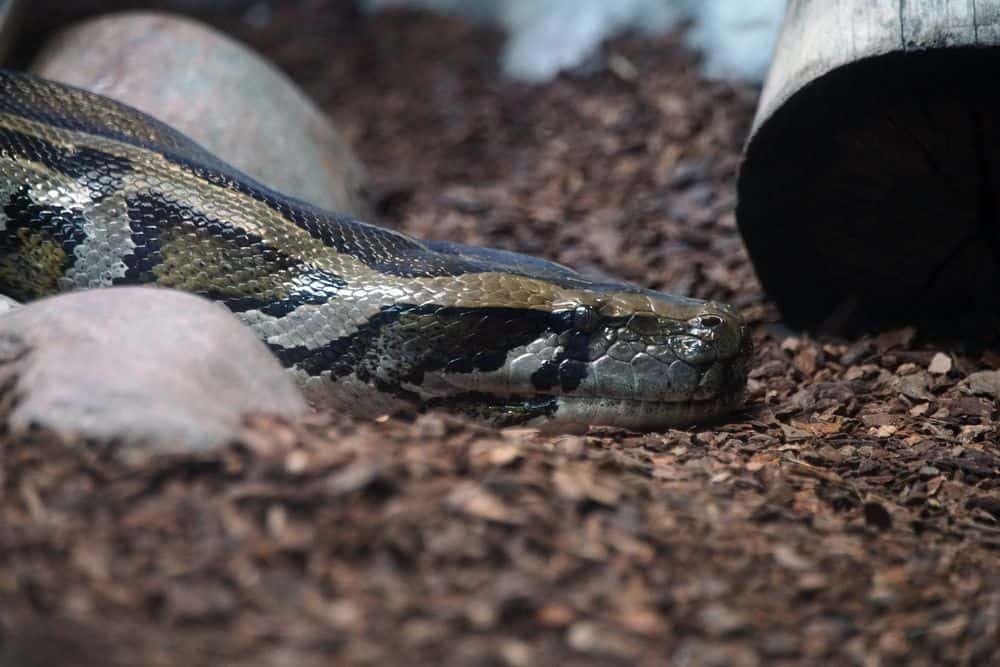
The Burmese python ranks as one of the largest snakes in the world. You’ll find these constrictors in Southeast Asia’s jungles and marshes.
These snakes can grow longer than a school bus. Their size gives them strength to overpower prey through sheer physical force.
Burmese pythons are mostly active at night. They prefer to hunt in darkness, using their bodies to ambush unsuspecting prey.
This snake’s constriction ability is impressive. When one wraps around its prey, it uses muscles to squeeze until the animal can’t breathe.
These snakes have become popular pets among experienced snake keepers. Their docile nature makes them easier to handle than you might expect from such a large snake.
They’ve also become an invasive species in places like Florida. You can see how their strength and adaptability help them survive in new environments.
5. African Rock Python
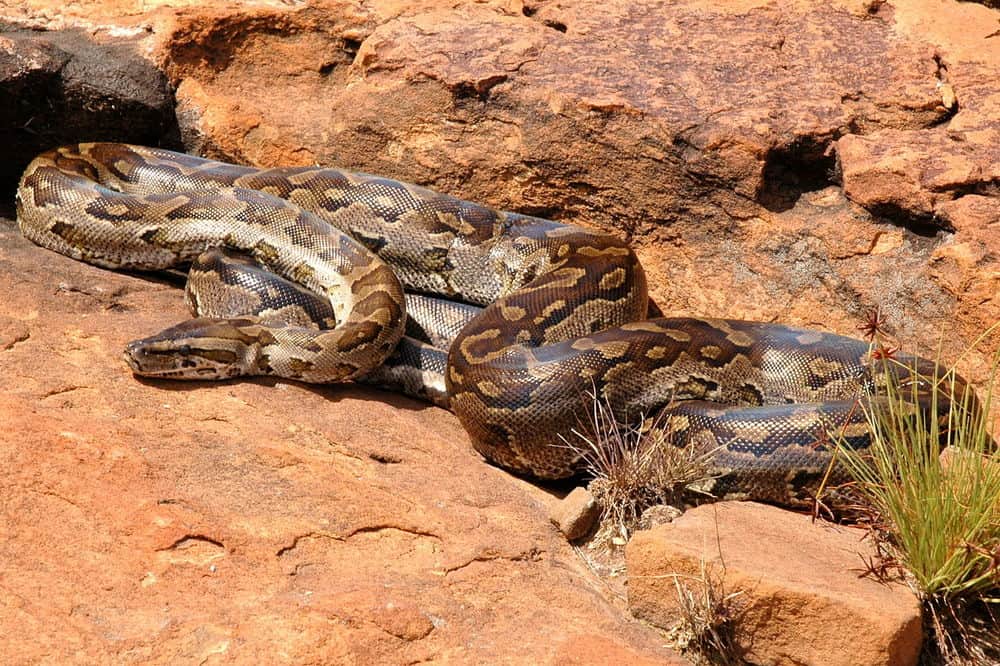
You’ll find the African rock python across sub-Saharan Africa. It is Africa’s largest snake species. The African rock python can grow over 20 feet long. Some reach up to 23 feet in length.
These pythons have incredible strength. They can wrap around and crush prey as large as hyenas and antelopes. Their powerful muscles squeeze until their prey can’t breathe.
These snakes can eat surprisingly large animals. They can swallow whole impalas, antelopes, and even crocodiles. Their flexible jaws stretch wide to fit huge meals.
You can spot African rock pythons in savannas, forests, and swamps. Their patterned scales help them hide from prey.
These pythons are swimmers and climbers. You might find them in trees or near water sources hunting for their next meal.
6. Indian Python

The Indian python is a large constrictor you can find in the Indian subcontinent. This snake is also called the black-tailed python or Indian rock python.
You’ll be impressed by its size. The Indian python can grow between 12 to 18 feet long. Some can even reach up to 21 feet in length.
The Indian python is the third largest snake in the world. Only the anaconda and reticulated python are bigger.
You can recognize this python by its beautiful patterns and colors. It has intricate designs that help it blend into its surroundings.
When hunting, the Indian python eats large rodents, rabbits, and chickens. It swallows its prey whole after squeezing it to death.
This constrictor plays a role in its ecosystem. It helps control animal populations by hunting various prey species in its natural habitat.
7. Yellow Anaconda
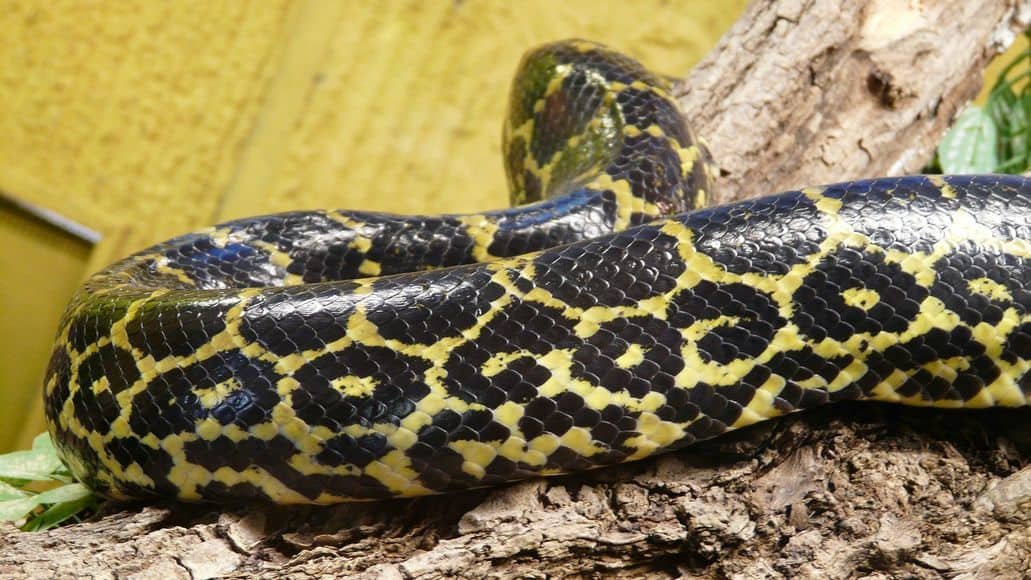
You might know the yellow anaconda as the smaller cousin of the famous green anaconda. This snake can grow up to 15 feet long and weighs much less than its giant relative.
You’ll find yellow anacondas in South America’s swamps and marshes. They love slow-moving rivers and wet areas where they can hunt easily.
The yellow anaconda gets its name from its bright yellow and black patterned skin. You can spot these snakes more easily than their green cousins because of their colors.
When you watch a yellow anaconda hunt, you’ll see why it’s such a strong constrictor. It wraps its body around prey and squeezes until the animal can’t breathe.
These snakes spend most of their time in or near water. You’re more likely to see them swimming than on land. This makes them excellent hunters in their watery homes. They hunt fish, birds, and small mammals that come near the water. Their strength lets them take down animals much larger than you might expect.
What Makes Constrictor Snakes So Powerful?
Constrictor snakes dominate their prey through muscle strength that can generate crushing pressures up to 300 pounds per square inch. Their success comes from specialized body design and smart hunting methods.
Muscular Anatomy And Mechanisms
Your body has muscles that work in pairs, but constrictor snakes have something much more powerful. They’ve got hundreds of vertebrae with ribs attached to each one.
This gives them flexibility and strength. The muscles wrap around their body in layers. When a snake squeezes its prey, these muscles work together like a living rope. Each time the prey breathes out, the snake tightens its grip a little more.
King snakes are the strongest constrictors pound for pound. Even though they are relatively small, the pressure they generate is strong enough to stop blood flow and breathing in their victims.
The snake’s muscles don’t get tired easily, either. They can maintain their grip for long periods without losing strength. This stamina lets them outlast prey that might struggle for several minutes.
Prey Capture Strategies
Constrictor snakes use smart hunting methods to catch their food. They don’t waste energy chasing fast animals. Instead, they wait for the right moment to strike.
Most constrictors are ambush predators. They hide in trees, bushes, or near water sources. When prey comes close, they strike quickly and wrap around it before it can escape.
The snake doesn’t crush bones like many people think. It stops the prey from breathing and cuts off blood flow. This method is called asphyxiation. The prey passes out within minutes.
Green anacondas can take down large animals like deer and caimans. They use their size and strength to overpower prey much bigger than themselves.
Role In Their Ecosystems
Constrictor snakes help keep animal populations balanced in their homes. They eat rodents, birds, and other animals that might become too numerous without predators around.
Boa constrictors control populations of mammals and birds in tropical areas. Without them, these animals could damage crops and spread diseases. The snakes act as natural pest control.
Many constrictors also eat other snakes, including venomous ones. King snakes regularly hunt rattlesnakes and other dangerous species. This protects other animals and humans from venomous snake bites.
Their presence shows that an ecosystem is healthy. When constrictor populations drop, it often means something is wrong with the environment. Scientists use them as indicators of habitat quality.
Conservation And Safety Around Constrictor Snakes
Many constrictor species face threats from habitat loss and the pet trade. Learning how to protect these snakes and stay safe around them helps both wildlife and people.
Protecting Natural Habitats
Constrictor snakes need healthy ecosystems to survive. You can help protect these serpents by supporting habitat conservation efforts.
Habitat destruction is the biggest threat to most constrictor species. When forests get cleared or wetlands get drained, snakes lose their homes.
Boa constrictors in Central and South America face this problem every day. The exotic pet trade also hurts wild populations. Many constrictors get caught and sold as pets. This removes breeding adults from their natural homes.
Here are ways you can help:
- Support wildlife protection groups
- Choose eco-friendly products
- Avoid buying wild-caught snakes as pets
- Donate to habitat restoration projects
Climate change affects constrictor habitats too. Rising temperatures and changing rainfall patterns make it harder for snakes to find food and shelter.
Tips for Safe Encounters
Most constrictor snakes steer clear of humans. Still, knowing how to act around them can keep everyone safe.
Never approach a large constrictor in the wild. Even snakes without venom might bite or squeeze if they feel threatened. Give snakes lots of space so they can move away on their own.
If you spot a constrictor:
- Stay at least 10 feet away
- Move slowly and calmly
- Don’t make sudden movements
- Back away if the snake looks agitated
Pet constrictors need special care. Large species like reticulated pythons or anacondas can be risky to handle. Never try to handle a big constrictor by yourself.
First aid for constrictor bites means cleaning the wound and keeping an eye out for infection. The bites aren’t venomous, but they can still cause trouble.
If you find a constrictor somewhere it shouldn’t be, call local wildlife officials. They’ll know how to safely remove and relocate the snake.
Strongest Constrictor Snakes: Conclusion
Constrictor snakes show off some wild strength, but not always in the way you’d expect. Size doesn’t always equal power with these animals.
The California kingsnake really drives that point home. Pound for pound, it’s the strongest constrictor out there. This smaller snake can take down prey that’s much bigger than itself. It’s honestly kind of impressive.
Giant constrictors like green anacondas and reticulated pythons use their sheer size to their advantage. They can handle huge animals like deer and even caimans.
Their weight lets them squeeze with a force that’s honestly hard to imagine. It’s not just about muscle—it’s about mass, too.
You can find constrictors in all sorts of places. They’re out there in:
- Tropical rainforests
- Deserts
- Grasslands
- Near water sources
They’re actually way more common than venomous snakes. Most won’t bother you unless you mess with them first.
Constriction works as a hunting method because the snake can feel the prey’s heartbeat through its coils. It waits to eat until it’s sure the animal’s dead.
Most constrictors belong to three main families:
- Pythons – Africa, Asia, and Australia
- Boas – the Americas
- Other constrictors – like kingsnakes and sand boas
Each species brings something unique to the table. Some climb, some swim, others burrow underground. Their strength helps them hunt and survive in some pretty tough spots. Nature really doesn’t mess around when it comes to snakes.
Leave a Reply